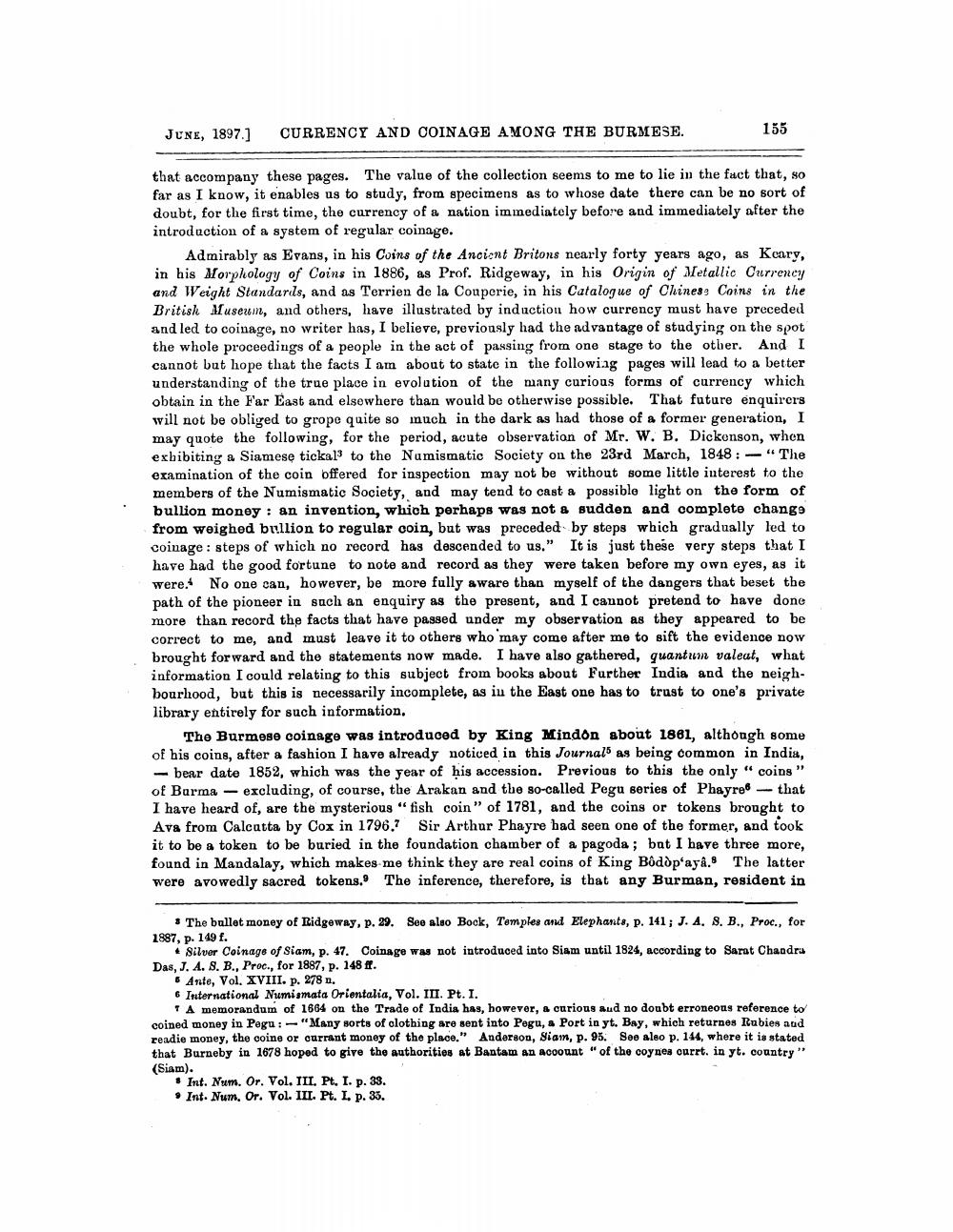________________
JUNE, 1897.]
CURRENCY AND COINAGE AMONG THE BURMESE.
155
that accompany these pages. The value of the collection seems to me to lie in the fact that, so far as I know, it enables us to study, from specimens as to whose date there can be no sort of doubt, for the first time, the currency of a nation immediately before and immediately after the introduction of a system of regular coinage.
Admirably as Evans, in his Coins of the Ancient Britons nearly forty years ago, as Keary, in his Morphology of Coins in 1886, as Prof. Ridgeway, in his Origin of Metallic Currency and Weight Standards, and as Terrien de la Couperie, in his Catalogue of Chinese Coins in the British Museum, and others, have illustrated by induction how currency must have preceded and led to coinage, no writer has, I believe, previously had the advantage of studying on the spot the whole proceedings of a people in the act of passing from one stage to the other. And I cannot but hope that the facts I am about to state in the following pages will lead to a better understanding of the true place in evolution of the many curious forms of currency which obtain in the Far East and elsewhere than would be otherwise possible. That future enquirers will not be obliged to grope quite so much in the dark as had those of a former generation, I may quote the following, for the period, acute observation of Mr. W. B. Dickenson, when exhibiting a Siamese tickal to the Numismatic Society on the 23rd March, 1848::-"The examination of the coin offered for inspection may not be without some little interest to the members of the Numismatic Society, and may tend to cast a possible light on the form of bullion money: an invention, which perhaps was not a sudden and complete change from weighed bullion to regular coin, but was preceded by steps which gradually led to coinage: steps of which no record has descended to us." It is just these very steps that I have had the good fortune to note and record as they were taken before my own eyes, as it were. No one can, however, be more fully aware than myself of the dangers that beset the path of the pioneer in such an enquiry as the present, and I cannot pretend to have done more than record the facts that have passed under my observation as they appeared to be correct to me, and must leave it to others who may come after me to sift the evidence now brought forward and the statements now made. I have also gathered, quantum valeat, what information I could relating to this subject from books about Further India and the neighbourhood, but this is necessarily incomplete, as in the East one has to trust to one's private library entirely for such information.
The Burmese coinage was introduced by King Mindon about 1861, although some of his coins, after a fashion I have already noticed in this Journals as being common in India, -bear date 1852, which was the year of his accession. Previous to this the only "coins " of Burma excluding, of course, the Arakan and the so-called Pegu series of Phayre. that I have heard of, are the mysterious "fish coin" of 1781, and the coins or tokens brought to Ava from Calcutta by Cox in 1796.7 Sir Arthur Phayre had seen one of the former, and took it to be a token to be buried in the foundation chamber of a pagoda; but I have three more, found in Mandalay, which makes me think they are real coins of King Bôdòp'ayâ.8 The latter. were avowedly sacred tokens. The inference, therefore, is that any Burman, resident in
The bullet money of Ridgeway, p. 29. See also Bock, Temples and Elephants, p. 141; J. A. S. B., Proc., for 1887, p. 149 f.
Silver Coinage of Siam, p. 47. Coinage was not introduced into Siam until 1824, according to Sarat Chandra Das, J. A. 8. B., Proc., for 1887, p. 148 ff.
Ante, Vol. XVIII. p. 278 n.
6 International Numismata Orientalia, Vol. III. Pt. I.
A memorandum of 1664 on the Trade of India has, however, a curious aud no doubt erroneous reference to coined money in Pegu: "Many sorts of clothing are sent into Pegu, a Port in yt. Bay, which returnes Rubies and readie money, the coine or currant money of the place." Anderson, Siam, p. 95. See also p. 144, where it is stated that Burneby in 1678 hoped to give the authorities at Bantam an account "of the coynes currt. in yt. country" (Siam).
Int. Num. Or. Vol. III. Pt. I. p. 33. Int. Num. Or. Vol. III. Pt. I. p. 35.




